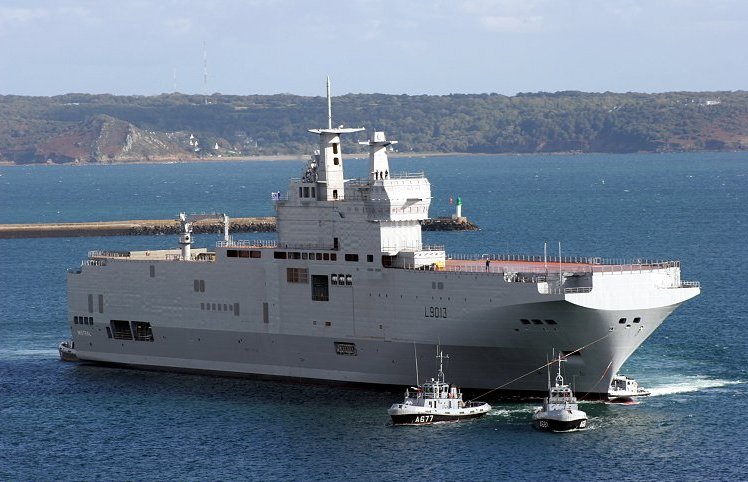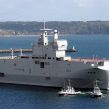
The Mistral Saga Takes a New Turn
Publication: Eurasia Daily Monitor Volume: 10 Issue: 22
By:

It is becoming clear that there will be major reversals in key elements of Russian defense policy as a result of the fall of Defense Minister Anatoly Serdyukov in November 2012. It is also equally clear that the real struggle is over what Serdyukov called the second phase of his reforms—namely the equipping of the Russian military with new weapons through a huge defense spending program of 23 trillion rubles (approximately $700 billion) through 2020. Serdyukov and his partners, Chief of the General Staff General Nikolai Makarov and Deputy Defense Minister Vladimir Popovkin, had made it clear they would buy foreign systems if the Russian defense industrial sector could not deliver satisfactory products. This policy ignited a firestorm of opposition from this extraordinarily well-connected sector, leading to the dismissal of Serdyukov and his entire hand-picked team.
The outstanding example of this struggle was the French-built helicopter carrier Mistral, which possesses capabilities far beyond those Russian firms could build. Russia is to take possession of two Mistrals built in France and has the option to construct two more under French license by Russia’s United Shipbuilding Corporation. As part of the technology transfer, Russian workers would take part in 20 percent of the work on the first ship and 40 percent on the second. If the option for the next two ships proceeds, Russia would undertake 80 percent of their construction at domestic shipyards (RIA Novosti, December 21, 2012; Baltic Times, March 9, 2011).
Indeed, through November it appeared that the first two Mistrals would be sent to the Pacific Fleet (Interfax, November 26, 2012). Yet, one month later, Deputy Prime Minister Dmitry Rogozin, overseer of the defense industrial sector and apparently a prime mover in the intrigue to unseat Serdyukov, announced that Russia would only decide to build the next two Mistral vessels after they had been “road-tested.” Moreover, the journal Vedomosti announced that Russia had actually entirely abandoned plans to build two more Mistrals (RIA Novosti, December 24, 2012; Vedomosti, December 21, 2012). Russian analysts explained that building two more Mistrals would cost about the same amount of money as paying France for the first two ships (1.7 billion euros or $2.4 billion), and their upkeep would also be a heavy burden on the budget (RIA Novosti, Vedomosti, December 21, 2012). Furthermore, military experts—although not Makarov, who was enthusiastic about the Mistral’s capabilities—and the shipbuilding industry loudly complained that there was no need for such vessels, that Russia could do it better, and that the purchase costs were too high (Interfax-AVN Online, December 21, 2012).
This clearly represents a victory for the domestic military industrial complex over the reformers and suggests that the real object of the struggle here was control over the vast procurement program and its funding, not any concept of national interest. Moreover, it apparently is not the only such victory for this sector. Already in October 2012, Vladimir Putin announced that the air force would be supplied largely with Russian-made aircraft (Interfax, October 4, 2012). Three weeks later, Rogozin made clear that Russia would buy foreign systems only to the extent that they reached an agreement on technology transfer to Russia. He argued that localization of production (i.e. in Russia) should be of an aggressive nature, whereby Russian workers might begin by constructing a minor portion of the system using domestic capabilities, but eventually produce the majority of the needed technologies locally (RIA Novosti, October 26, 2012).
Procurement spending will triple from 908 billion rubles ($30 billion) in 2012 to 2.8 billion in 2015 ($92 billion) (RIA Novosti, December 27, 2012). This constitutes an enormous honey pot for the defense industrial sector. Nevertheless, contract fulfillment and high quality standards continue to be a problem; even Belarusian President Alyaksandr Lukashenka had openly complained (Chater97.org, October 24, 2012).
Procurement delays also remain widespread. The travails of the Bulava missile—Russia’s future submarine-based naval deterrent—and its 12 tests before approval were widely reported. The ongoing fiasco of the Gorshhkov carrier for India is another example. The Navy’s new missile gunnery system, the Pantsir-M, meanwhile, will be delayed by at least three years (www.b-port.com, November 6, 2012). The reform of Moscow’s automated tactical command-and-control (C2) system has also been mired in setbacks, showing the state’s inability to oversee the defense sector properly, and the sector’s inability to meet state requirements (see EDM, December 4, 2012; Nezavisimoye Voyennoye Obozreniye, November 12, 2012). Failure in this area places at risk the whole effort of digitizing the army and making it capable of network-centric warfare. These facts have already led Serdyukov’s successor, Sergei Shoigu, to warn that if aircraft prices continue to increase due to delays and inflation in basic commodities—since 2008, commodities prices rose by 300–500 percent—Russia may have to buy foreign planes (Interfax-AVN Online, November 23, 2012).
In many other cases, the armed forces have openly refused to accept Russian-produced weapons, such as the Pantsir air defense system, which Moscow also exports. Whereas, the new Ilyushin IL-476 heavy transport aircraft’s specifications do not correspond to the characteristics required for combat conditions (Nezavisimoye Voyennoye Obozreniye, October 3, 2012; Izvestiya Online, September 14, 2012). Meanwhile, the Navy has already denigrated the design of Russia’s first new nuclear-powered aircraft carrier, to be deployed in 2018 as both a powerful strike platform and command-and-control center. The Navy claims the planned carrier’s designers, hoping to pocket vast sums of government money, offered a copied proposal of the now obsolete Soviet aircraft cruiser Ulyanovsk, which was not built because of the Soviet Union’s collapse (Izvestiya Online, November 26, 2012). Such complaints are not incidental affairs. In 2011, complaints from clients about the poor quality of Russian-made arms covered contracts totaling 24 billion rubles ($779 million) (www.valdaiclub.org, December 6, 2012).
These examples suggest a return in Russia to the Leonid Brezhnev period when the Armed Forces were obligated to accept domestic-made arms regardless of their quality or the military’s demands. The current struggle over Russian defense procurement contracts is clearly driven by control over financial flows and access to corruption. Undoubtedly there will be some amount of modernization. But essentially the old order has triumphed here, as in so many other sectors of Russian politics and life.




